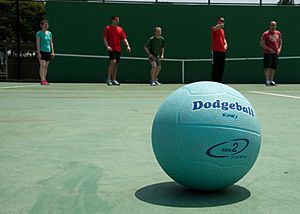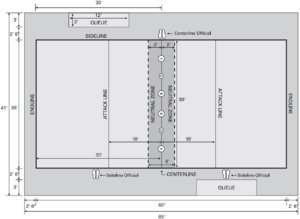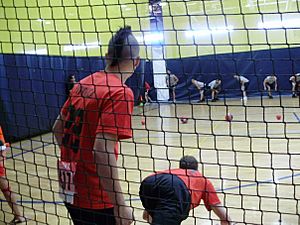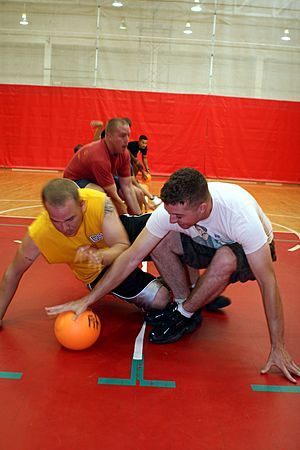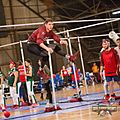Dodgeball facts for kids
Dodgeball is a fun sport where players throw soft or rubber balls at each other. The main goal is to be the last player left without getting hit by a ball. You can only throw balls at players on the other team. If a ball hits you, you are usually out and might go to the side of the court. From there, you might even be able to throw balls back into the game!
This game is popular in elementary school physical education classes. Many kids enjoy playing it. Some adults who played as children have even started their own dodgeball clubs. Sometimes, schools have made it against the rules to play dodgeball because players can get hurt. Still, many schools hold exciting dodgeball tournaments.
Contents
Equipment for Dodgeball
The number of dodgeballs used in a game can change. Usually, three to ten balls are used. If the playing area is small or many people are playing, the number of balls might be different. More balls often make the game more exciting. Six balls are usually needed for a game with official rules. It's often good to have an odd number of balls, like five or seven. This way, one team will have more balls and can start attacking.
Dodgeball can be played with different types of balls. The most common types are:
- Cloth balls: These are used in many countries.
- Foam balls: Popular in North America and some parts of Asia.
- Rubber balls: Also popular in North America and some parts of Asia.
Where Dodgeball Is Played
Dodgeball is often played on courts used for other sports. These can include:
- A basketball court
- A volleyball court
- A fenced area
- Even a large field like an Australian Rules Football oval or a soccer pitch
There isn't one special design for a dodgeball court. Players usually use the best available flat area. Most games need a center line on the court.
How to Play Dodgeball
At the start of a dodgeball game, the balls are placed on the middle line of the court. In some games, the balls are thrown into the air or shared equally between teams. Players then run towards the center line at the same time. They try to grab a dodgeball and throw or roll it back to their teammates. Players cannot pick up a ball and throw it right away. In some games, balls must be behind a "check line" before they can be thrown. This start is called the "opening rush." Once the game begins, players throw balls at the other team to get them out.
Getting Players Out
A player is out if a dodgeball hits them directly. This means the ball didn't hit the roof, floor, walls, or another object first. If the ball hits you and no one catches it before it drops, you are out. You must then go to your team's bench area. You are also out if the ball bounces off another dodgeball or player and then hits you. If several people try to catch a ball but drop it, the person hit is still out.
Sometimes, rules about "headshots" (balls hitting a player in the head) can vary. Depending on the rules, the person who threw the ball might be out, or the person hit might be out, or both.
Catching the Ball
If a player catches a ball thrown by the other team directly, the player who threw the ball is out. As long as the ball is caught and held for at least two seconds, the thrower is out. This is true even if you catch the ball in a tricky way, like between your legs!
If a dodgeball hits a player but then a teammate catches it, the thrower is out. The player who was hit stays in the game, and one player who was out can come back into the game.
Special Rules and Eliminations
In games played on a basketball court, if a player throws the ball and it goes into the opposing team's basket or hits the basketball backboard directly, their whole team gets to bring back all their eliminated players. This counts even if the ball bounced off another dodgeball or was deflected by an opponent. If the ball hits only the basket ring or supports but not the backboard or hoop, nothing special happens. Players cannot be called out if the ball hits the backboard, its supports, or the ring.
Players can pick up balls that are not in play and throw them back at the other team. Players are allowed to go outside the court to get balls that have rolled away. However, they cannot throw the ball until they are back inside the court. If a player throws a ball from outside the court, they are automatically out, and the ball cannot get an opponent out.
A player is also out if they move completely out of bounds to avoid a ball and don't catch it. If a player goes into the opponent's side of the court or picks up a ball from there when it hasn't fully rolled into their own side, they are out. Players can also be eliminated for bad sportsmanship or cheating. Kicking the balls is not allowed.
Blocking Balls
Sometimes, players can use a ball they are holding to block incoming balls from the other team. However, depending on the rules, if a player drops the ball they are using to block, or if the ball is knocked out of their hands by an opponent's throw, that player might be out.
Winning the Game
The game ends when all players on one team are eliminated. The team with players still in the game wins!
Alternate Rule: No Lines
When only a few players are left on each team, it can be very easy to dodge the ball because there's so much space. In this situation, an alternate rule called "No Lines" or "open court" might be used. When "No Lines" is announced, the boundary lines no longer count. Players can go anywhere on the court to get a better shot at their opponents.
Images for kids
See also
 In Spanish: Balón prisionero para niños
In Spanish: Balón prisionero para niños


